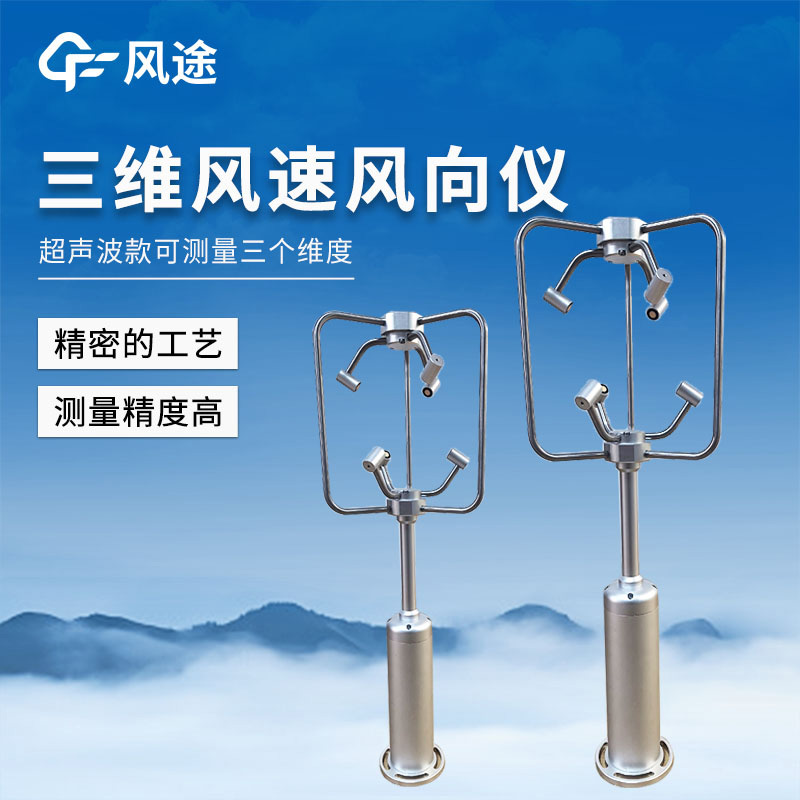Shandong Fengtu IOT Technology Co., Ltd
Sales Manager:Ms. Emily Wang
Cel,Whatsapp,Wechat:+86 15898932201
Email:info@fengtutec.com
Add:No. 155 Optoelectronic Industry Accelerator, Gaoxin District, Weifang, Shandong, China

Sales Manager:Ms. Emily Wang
Cel,Whatsapp,Wechat:+86 15898932201
Email:info@fengtutec.com
Add:No. 155 Optoelectronic Industry Accelerator, Gaoxin District, Weifang, Shandong, China
time:2025-03-06 08:54:19 source:Weather Station viewed:224 time
Traditional cup anemometers are widely used in the field of wind power measurement, but they have obvious limitations. It can only measure the synthetic wind speed in the horizontal plane at the installation height of the wind measuring tower, and based on this, it can complete the statistical calculation of the ten-minute average wind speed and turbulence intensity. Its measurement principle determines that the wind speed is easily affected by various factors: the friction force of the shaft will generate mechanical resistance, affecting the rotation of the wind cups; the moment of inertia of the wind cups will make the instrument respond slowly when the wind speed changes; the temperature effect will change the physical properties of the materials, thus affecting the measurement accuracy; the cosine response will lead to measurement deviations in non-ideal wind direction situations. The combined effect of these factors makes it difficult to guarantee the measurement accuracy and increases the uncertainty of the cup anemometer in low wind speed areas, environments with large temperature differences, and complex terrains such as mountains.
In terms of physical essence, the airflow velocity at a certain point in space is a typical vector, which has not only magnitude but also direction. However, due to the limitations of its working principle, the cup anemometer can only measure the magnitude of the velocity and cannot obtain the direction information of the airflow. In sharp contrast, the three-dimensional ultrasonic anemometer measures the air flow velocity based on the difference in the propagation speed of ultrasonic pulses in the downwind and upwind directions.
Specifically, it uses three pairs of probes arranged perpendicular to each other, which can simultaneously measure the wind speed components in three directions. This enables the 3D Ultrasonic Anemometer not only to calculate the direction of the airflow but also to calculate the inclination angle of the airflow in the vertical direction by analyzing the wind speed components in the three directions, thus achieving a comprehensive measurement of the airflow vector.
Compared with the cup anemometer, the 3D Ultrasonic Anemometer has unparalleled advantages.
First, it has higher measurement accuracy and can more accurately reflect the actual wind speed situation; second, it has lower uncertainty, providing a more reliable basis for wind resource assessment; third, it can obtain three-dimensional wind speed information simultaneously, which is particularly important for measuring the wind resource conditions in complex terrains. Complex terrains are often accompanied by complex changes in the airflow, and these advantages of the 3D Ultrasonic Anemometer enable it to complete the measurement tasks more accurately.
In practical applications, the three-dimensional ultrasonic anemometer can work according to the fixed ground coordinate system and collect the time series of three-dimensional wind speed components (X, Y, and Z are the coordinate axes of the fixed ground coordinate system). For the collected three-dimensional wind speed data, there are two statistical methods: the scalar method and the vector method. Both methods can be used to statistically analyze the ten-minute average wind speed, turbulence intensity, and the annual distribution probability of the average wind speed. These statistical results are of great significance for estimating the annual power generation of wind farms, and can also provide key data support for the simulation calculation of the power curves and loads of the units at each turbine location, thus providing a powerful guarantee for the design, operation, and optimization of wind farms.

The scenic area meteorological station can achieve diversified monitoring functions through the all-round three-dimensional real-time monitoring of "land, sea and air". It can monitor multiple environmental parameters including air quality, water quality, noise level, temperature, humidity...
As an emerging instrument in the field of meteorological observation, the Portable Weather Station is gradually changing the way meteorological data is collected. It is small in size and light in weight, with extremely strong mobility, making it effortless to carry and transport. Whether it is for c...
The FT-Y1S metal piezoelectric rain gauge is a high-precision rainfall measurement device suitable for various field monitoring scenarios. It utilizes a PVDF piezoelectric film as its core sensing component, capable of accurately detecting the physical signals generated by raindrop impacts. The sens...
In the fields of meteorological observation and environmental monitoring, visibility is a key indicator. Although traditional ground visibility monitoring stations can provide certain data, they have shortcomings such as limited monitoring range and difficulty in covering complex terrain. With the d...